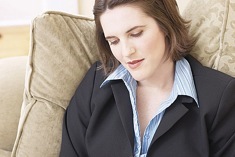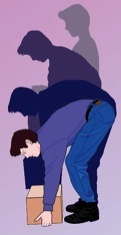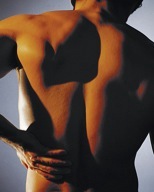













-
Muscle & Bone Problems
Back Pain
Signs & Symptoms
Back pain can be:
-
•Sharp.
-
•Dull.
-
•Acute.
-
•Chronic.
There may also be swelling in the back area.
Causes
The most common cause is muscle strain of the lower back. Other causes include back injuries, osteoarthritis, osteoporosis, and bladder infections.
Treatment
Most backaches are caused by strained muscles and ligaments and can be treated with self-care. (See Self-Care / Prevention below.) Other causes need a medical evaluation and treatment specific to the problem.
The goals of treatment are to treat the cause, relieve the pain, promote healing, and avoid re-injury.






















Get comfortable when you sit.
Apply ice or a cold pack for the first 48 hours after symptoms start.
Other Tips
-
•Get comfortable when you lie down, stand, and sit. For example, when you lie on your back, keep your upper back flat, but your hips and knees bent. Keep your feet flat on the bed. Tip your hips down and up until you find the best spot.
-
•Put a pillow under your knees or lie on your side with your knees bent. This will take pressure off your lower back.
-
•When you get up from bed, move slowly, roll on your side, and swing your legs to the floor. Push off the bed with your arms.
Cold Treatment
Cold helps with bruises and swelling. For the first 48 hours after back symptoms start, apply a cold pack (or bag of ice) to the painful area. Lie on your back with your knees bent and put the cold pack under your lower back. Do this for 5 to 10 minutes at a time, several times a day.
Heat Treatment
Heat makes blood flow which helps healing. Heat also helps relieve muscle spasm. Don’t use heat on a back strain until 48 or more hours after back symptoms start. Use cold treatment first (see “Cold Treatment” above). If used sooner, heat can make the pain and swelling worse. Use a moist heating pad, a hot-water bottle, hot compresses, a hot tub, hot baths, or hot showers. Use heat for 10 minutes at a time. Do this several times a day. Be careful not to burn yourself.

Braces or Corsets
Braces and corsets help to support your back and keep you from moving it too much. They do what strong back muscles do, but they won’t make your back stronger.
Massage
Massage won’t cure a backache, but it can loosen tight muscles.
Spinal Manipulation
This treatment, usually done by a chiropractor or osteopath, uses the hands to apply force to “adjust” the spine. This may be especially helpful for some people the first month they have low back symptoms. Consult your doctor about spinal manipulations. Your health insurance plan may require a referral from your doctor before it pays anything for spinal manipulation.
More Tips
-
•Try some mild stretching exercises (in the morning and afternoon) to make your stomach and back muscles stronger. Ask your doctor for his or her advice on exercising.
-
•Don’t sit in one place longer than you need to. It strains your lower back.
-
•Sleep on a firm mattress. Don’t sleep on your stomach. Sleep on your back or side with your knees bent.
-
•If your back pain is chronic or doesn’t get better on its own, see your doctor who can evaluate your needs. Your doctor may refer you to a chiropractor, physical therapist, or physiatrist (a physical therapy doctor).
Lifting Do’s and Don’ts to Prevent Back Strain


Proper Lifting.
Improper Lifting.
Don’ts
-
•Don’t lift if your back hurts.
-
•Don’t lift if you have a history of back trouble.
-
•Don’t lift something that’s too heavy.
-
•Don’t lift heavy things over your head.
-
•Don’t lift anything if you’re not steady on your feet.
-
•Don’t bend at the waist to pick something up.
-
•Don’t arch your back when you lift or carry.
-
•Don’t lift too fast or with a jerk.
-
•Don’t twist your back when you are holding something. Turn your whole body, from head to toe.
-
•Balance the load. Don’t lift something heavy with one hand and something light with the other.
-
•Don’t try to lift one thing while you hold something else. For example, don’t try to pick up a child while you are holding a bag of groceries. Put the bag down or lift the bag and the child at the same time.
Sciatica
Sciatica is inflammation of the sciatic nerve, which starts in the lower spine and goes down the back of the legs. Pressure on the nerve (from tight muscles, herniated disk, etc.) causes a sharp pain that can be felt in the buttock and may extend to the thigh, knee, or foot. To prevent sciatica:
-
•Don’t strain the muscles in your lower back. (See Lifting Do’s and Don’ts to Prevent Back Strain above.)
-
•Do exercises to strengthen your stomach muscles. These exercises help make your back stronger.
Treatment for mild sciatica is rest, heat, and over-the-counter medicine for pain. Physical therapy may be helpful. In some cases, surgery to repair a herniated disk may be needed.
Self-Care / Prevention
Relieve the Pain
Take an over-the-counter medicine for pain. Acetaminophen will help with pain, but not with swelling. Don’t “overdo it” after taking a painkiller. You can hurt your back more and then it will take longer to heal.
Activity
Continue your regular activities as much as you can, but stop activities that increase pain. Rest the
back if you must, but don’t rest in bed more than 1 to 2 days even if your back hurts a lot. Your back muscles can get weak if you don’t use them or if you stay in bed longer than 2 days. Bed rest should only be used for persons with severe limitations (due mostly to leg pain).
Did the back pain start inside the chest and move to the upper back? (This could be a sign of a heart attack.)
Is the back pain extreme and felt across the whole upper back? Did it come on suddenly (within about 15 minutes) without a reason, such as an injury or back strain? (These may be symptoms of a dissecting aortic aneurysm.)
Was the back pain sudden with a cracking sound? Or, does the pain occur with passing out and/or severe abdominal pain?
Did the pain come after a recent fall, injury, or violent movement to the back and are you having a hard time moving your arm or leg? Do you also have numbness or tingling in your legs, feet, toes, arms, or hands, and/or loss of bladder or bowel control?
Did the pain come on all of a sudden after being in a wheelchair or a long stay in bed or are you over 60 years old?
Is the pain severe (but not a result from a fall or injury to the back) and has it lasted for more than 5 to 7 days? Or, is there also a sense of weakness, numbness, or tingling in the feet or toes?
Do you have symptoms of kidney stones or symptoms of a bladder infection?
Does the pain travel down the leg(s), especially below the knee(s)?
Does it hurt more when you move, cough, sneeze, lift, or strain?
Is the pain felt on one side of the small of your back, just above your waist, and do you feel sick and have a fever of 101ºF or higher?
With back pain, do you have any of these problems?
-
•Fever, joint stiffness, and pain.
-
•Fever, redness, heat, or swelling in affected joints.
-
•Fever, cracking or grating sounds with joint movement.

Back pain can be felt on one or both sides of the back.
Questions to Ask
Do’s
-
•Wear good shoes with low heels, not sandals or high heels.
-
•Stand close to the thing you want to lift.
-
•Plant your feet squarely, shoulder width apart.
-
•Bend at the knees, not at the waist. Keep your knees bent as you lift.
-
•Pull in your stomach and rear end. Keep your back as straight as you can.
-
•Hold the object close to your body.
-
•Lift slowly. Let your legs carry the weight.
-
•Get help or use a dolly to move something that is too big or very heavy.




Get more information from:
HealthyLearn® | www.HealthyLearn.com. Click on MedlinePlus®.
National Institute of Arthritis and Musculoskeletal and Skin Diseases (NIAMS) | www.nih.gov/niams



Copyright © 2009, American Institute for Preventive Medicine. All rights reserved.